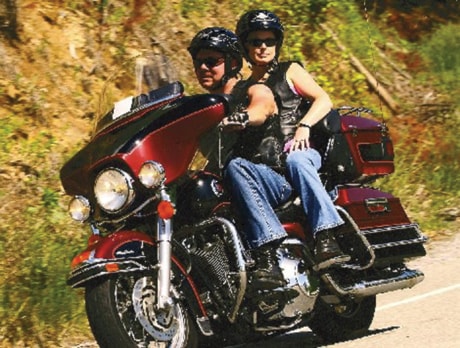VANCOUVER — It’s springtime and a young man’s thoughts turn to ... the motorcycle under cover in the garage.
Not just young men, of course, but baby boomers fulfilling youthful dreams and an increasing number of women are opting for two-wheeled motorized transport, especially scooters.
What they have in common is the shocked look on their faces when they go to insure their rides.
Premiums for motorcycles and even micro-engined scooters approach that of cars, and often more.
Guy Shank of Sudbury, Ont., pays $1,100 a year to insure his Harley Davidson Electra Glide cruiser bike, even though he parks it over the winter.
The 50-year-old family man has been riding since he was 16 and winces every time he writes the cheque, remembering how little it cost when he was younger.
“It was dirt cheap to run insurance on a bike,” he says. “I don’t remember insurance being a problem at all.”
It’s hard to say whether that’s accurate or simply nostalgia talking, but there’s no disputing motorcycle and scooter insurance today is costly.
The reason is simple: Motorcycle accidents are expensive for insurance companies.
A 2008 report by the Traffic Injury Research Foundation noted mushrooming ridership in Canada in the last decade and found that while the number of automobile crashes is declining, motorcycle accidents are growing.
More plentiful U.S. data shows fatalities more than doubled between 1996 and 2006, while auto fatalities declined.
The report says the figures are all the more troubling because motorcycles are a tiny fraction of the number of registered vehicles and travel fewer kilometres each year.
Data from 2004-08 collected by Crown-owned Insurance Corp. of British Columbia (ICBC), which provides mandatory insurance for all vehicles in the province, shows on average 27 per cent of motorcycle crashes were single-vehicle accidents.
In multi-vehicle crashes involving motorcycles, the bike’s rider was deemed at fault 25 per cent of the time.
But the most significant factor in insurance costs is that motorcycle injuries tend to be more serious than for automobile occupants.
A car offers the protection of crumple zones, a steel passenger cage, airbags and seat belts. A motorcyclist, even wearing full leathers, is completely vulnerable to impacts.
“If you are in a crash it’s 15 times more likely to be in a fatal crash and three times more likely to be injured than if you’re in a car,” says Kellee Irwin, ICBC’s vice-president of insurance marketing and underwriting.
Irwin has been riding motorbikes since she was five, competed in off-road races nationally and owns a stable of motorcycles.
But she’s completely objective about the risk motorcyclists pose for insurers.
“Obviously with the higher frequency of injuries it’s a more expensive insurance product,” Irwin says, adding motorcycle injuries also tend to be worse because of the rider’s exposure.
Ultimately a motorcyclist’s insurance costs depend a lot on where they live. Provinces with government programs, such as B.C., Saskatchewan and Manitoba, create a different environment from fully private systems.
Like their car-driving counterparts, B.C. motorcyclists must have ICBC’s compulsory accident and liability insurance but can buy collision and other optional coverage from private companies.
ICBC’s compulsory accident benefits — injury treatment, rehabilitation, wage loss, etc. — for all vehicles are capped at $150,000. Claimants can sue to recover anything above that.
But in Ontario’s non-fault private insurance environment, the costs are even greater because accident benefits generally are not capped.
That’s helping drive premiums through the roof, says Dan Avon, a broker with Dalton Timmis Insurance of Ancaster, Ont.
“We’ve just had two major insurance companies take 33 per cent rate increases this year and they took a 15 last year, so rates are up 45-48 per cent,” he says.
“And that’s just bringing them up in line with other companies. The average policy premium’s raised $300-$400 on a regular $800 policy.”
Dalton Timmis has developed a substantial motorcycle insurance business in Ontario and Alberta — including its homeforchrome.com website. But Avon says finding the right coverage is hard for riders and brokers alike.
Motorcyclists essentially have two choices, he says — find an insurer specializing in bikes or insure through the same company that handles your home and automobile policies.
The specialty underwriters may offer attractive rates, but there aren’t many of them, their rates can fluctuate and there’s no guarantee they’ll be in that business from one year to the next, says Avon.
“The niche players have never been a stable environment for motorcycles and that’s why you hear so much negativity and complaints about motorcycle insurance,” he says.
A big-tent insurer may not offer some of the bells and whistles of the specialty firm, but rates can be more stable.
“It’s because they’re offsetting their losses by having the home and auto (insurance),” says Avon.
When it comes to tips for getting the best insurance deal there seem to be no hard and fast rules, except perhaps keeping one’s claims record clean.
As a rule, the bigger a bike’s engine displacement, the higher the premium. So the lure of more power will come with a price.
And new riders tend to get soaked more than veterans, although companies may factor experience differently.
Avon also advises shoppers to scrutinize the coverage carefully. Beware of brokers who offer “full coverage” packages at cheap rates.
